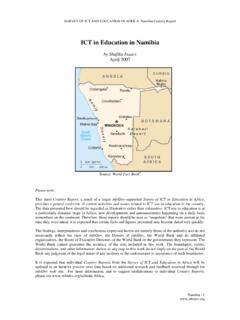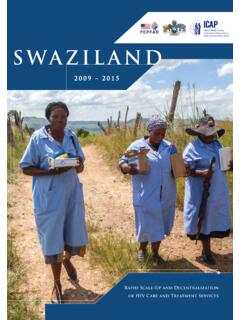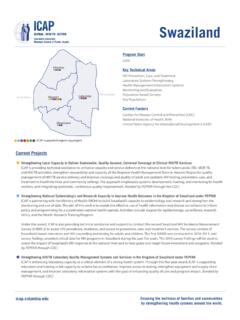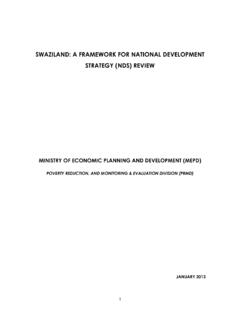Transcription of ICT in Education in Swaziland - infoDev
1 SURVEY OF ICT AND Education IN AFRICA: Swaziland Country Report Swaziland - 1 ICT in Education in Swaziland by Shafika Isaacs April 2007 Source: World Fact Book1 Please note: This short Country Report, a result of a larger infoDev -supported Survey of ICT in Education in Africa, provides a general overview of current activities and issues related to ICT use in Education in the country. The data presented here should be regarded as illustrative rather than exhaustive. ICT use in Education is at a particularly dynamic stage in Africa; new developments and announcements happening on a daily basis somewhere on the continent.
2 Therefore, these reports should be seen as snapshots that were current at the time they were taken; it is expected that certain facts and figures presented may become dated very quickly. The findings, interpretations and conclusions expressed herein are entirely those of the author(s) and do not necessarily reflect the view of infoDev , the Donors of infoDev , the World Bank and its affiliated organizations, the Board of Executive Directors of the World Bank or the governments they represent. The World Bank cannot guarantee the accuracy of the data included in this work. The boundaries, colors, denominations, and other information shown on any map in this work do not imply on the part of the World Bank any judgment of the legal status of any territory or the endorsement or acceptance of such boundaries.
3 It is expected that individual Country Reports from the Survey of ICT and Education in Africa will be updated in an iterative process over time based on additional research and feedback received through the infoDev web site. For more information, and to suggest modifications to individual Country Reports, please see SURVEY OF ICT AND Education IN AFRICA: Swaziland Country Report Swaziland - 2 Overview Swaziland is a small, deeply impoverished, drought-stricken country with a weak ICT infrastructure. The Swazi government introduced a draft national ICT policy in 2006 and the country has a very small number of ICT for Education programmes under way of which the Computer Education Trust and various programmes at the University of Swaziland are the most known.
4 Country Profile Swaziland is one of the smallest, landlocked countries on the African continent. While considered one of the wealthier nations in Africa, it remains one of the poorest in the world. Seventy percent of Swazis live in rural areas. A continuing drought has resulted in a food crisis that threatens hundreds of thousands or people with hunger. The unemployment rate is approximately 40%, and nearly 70% of the population live on less than a dollar per day. Economic growth has wavered in the past few years, exacerbated by the economy s inability to create new jobs at the same rate that new job seekers enter the market.
5 This situation is due largely in part to the population growth rate, which strains the natural resources and the country s ability to provide adequate social services, such as health care and Education . Overgrazing, soil depletion, and floods are persistent problems. Largely as a result of having the world s highest rate of HIV infection, Swaziland has the lowest life expectancy on the planet: just years. This is expected to drop to just 29 years by the year Table 1 provides a brief overview of basic socio-economic indicators for the country. Table 1: Socio-economic Indicators: Swaziland Indicator Population million (2005) Languages Official languages: English and siSwati.
6 Other languages: Tsonga and Zulu 2005 Economic activity (% of GDP) Agriculture: Industry: Services: Human Development Index 146 (out of 177 countries)3 Per capita gross national income (US dollars) $1,700 (2004); $2,280 (2005) The Education System Education and training is divided into four main sub-sectors in Swaziland : SURVEY OF ICT AND Education IN AFRICA: Swaziland Country Report Swaziland - 3 Early childhood care and development (ECCD) Primary Education Secondary Education Post-secondary Education Primary Education in Swaziland is seven years with the age range from six to 13 years. Parents have always contributed towards primary Education by paying school fees and contributing to a building fund (for construction of school facilities).
7 As a measure to reduce the cost burden to parents, the Government of Swaziland now provides free textbooks to all primary school pupils and offers bursaries for destitute and orphaned children. The government is also exploring the possibility of providing primary school pupils with Secondary Education is divided into two sub-systems: three years of junior secondary and two years of senior secondary. Post-secondary Education consists of tertiary Education and vocational Education , which is offered by various institutions. In 2001 there were 723 schools in Swaziland : 541 primary and 182 secondary. Swaziland has one national university as well as teacher-training and nurse-training colleges and a few skills-training institutes.
8 Swaziland s adult literacy rate for 2000-2004 stood at 80%. The net primary school enrolment was 77% during the same period. Challenges AIDS is having a devastating impact on children in Swaziland . An estimated 69,000 children have been orphaned due to AIDS-related causes, and an additional 60,000 are highly vulnerable due to the extreme poverty of caregivers, the sickness of parents, or home situations of abuse and exploitation. As a result of the impact of AIDS, more than one-third of children cannot access basic services, including health, food, Education , water and sanitation, and psychosocial support. While neighbourhood care points help many of the poorest and most vulnerable to meet basic needs, they reach only about 20% to 25% of orphaned and vulnerable children.
9 Swaziland s under-five mortality rate, estimated at 74 per 1,000 live births in 1995, now stands at 156 per 1,000. The plight of children has been further exacerbated by successive years of drought, which have left one-third of the country s children stunted and one-third of the country s population dependent on food aid. The regional food crisis in 2006 will aggravate the situation, further increasing the burden on communities already trying to take in orphaned Infrastructure SURVEY OF ICT AND Education IN AFRICA: Swaziland Country Report Swaziland - 4 The telecom sector in Swaziland features an old-style posts and telecom monopoly operator for fixed services but with private participation in mobile and Internet services.
10 Nevertheless, fixed and mobile penetration is relatively high compared with other countries in the region. While Internet usage is growing reasonably fast, the level of penetration is still well below international standards, but about average in the region. The government is considering unbundling the national operator to create discrete telecom and regulatory entities and later privatise them. Table 2 provides an overview of the country s ICT infrastructure indicators. Table 2: ICT Infrastructure Indicators, 2004 Indicator Fixed-line subscribers per 1,000 persons Mobile subscribers 113 per 1,000 persons Dial-up subscribers per 1,000 persons Broadband subscribers Internet users per 1,000 persons Television broadcast stations 12 (including 7 relay stations) Radio stations AM 3; FM 2; shortwave 3.











